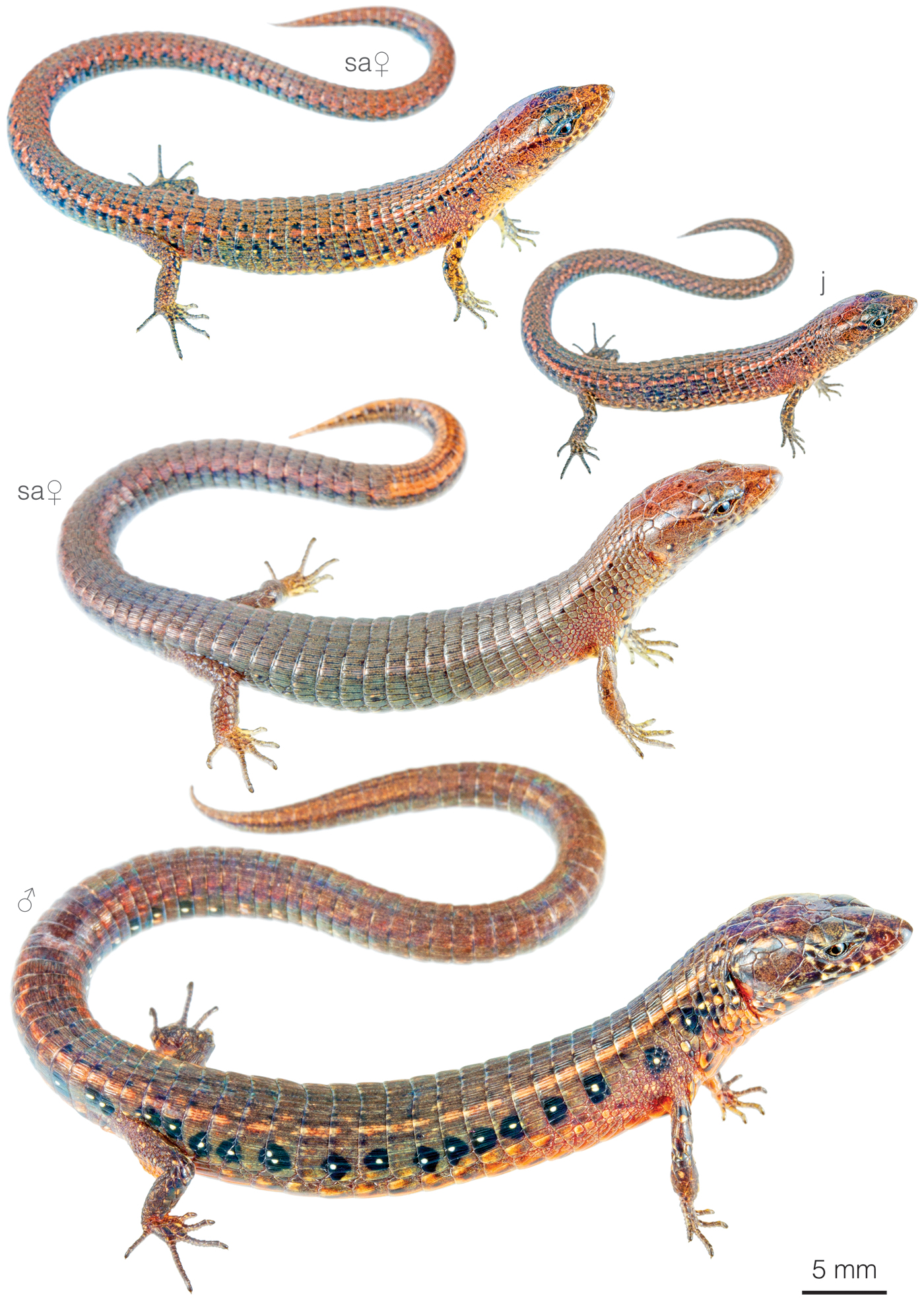Published August 28, 2020. Updated November 20, 2023. Open access. Peer-reviewed. | Purchase book ❯ |
Western Andean-Lizard (Andinosaura vespertina)
Reptiles of Ecuador | Sauria | Gymnophthalmidae | Andinosaura vespertina
English common names: Western Andean-Lizard.
Spanish common names: Lagartija andina occidental.
Recognition: ♂♂ 17.4 cmMaximum distance from the snout to the tip of the tail. Snout–vent length=6.6 cm. ♀♀ 18.1 cmMaximum distance from the snout to the tip of the tail. Snout–vent length=6.9 cm..1,2 The Western Andean-Lizard (Andinosaura vespertina) differs from all other lizards in its area of distribution by lacking prefrontal scales and by having extremities so short that the front and hind limbs do not overlap when pressed against the body.1,2 Adult males are more robust than females and are easily recognizable by their reddish flanks with ocelli consisting of a black circle with a white spot in the middle. Adult females are brownish overall and lack ocelli (Fig. 1).3 Individuals of A. vespertina are usually found living alongside individuals of Macropholidus annectens,3 a species of lizard characterized by having longer limbs.

Figure 1: Western Andean-Lizards (Andinosaura vespertina) from Utuana Reserve, Loja province, Ecuador. sa=subadult, j=juvenile.
Natural history: Andinosaura vespertina is a rarely seen cryptozoic lizard that inhabits moist, shaded microhabitats in old-growth to moderately disturbed dry highland shrublands and pine tree plantations.2,3 Western Andean-Lizards spend most of their lives hidden under soft soil, leaf-litter, rocks, and logs,3 but may also occasionally be seen moving at ground level during the day.1 Gravid females contain two eggs and lay them in communal nesting sites.2 When threatened, individuals of A. vespertina flee into crevices. If captured, they may bite or readily shed the tail.3
Conservation: Endangered Considered to be facing a high risk of extinction in the near future.. Andinosaura vespertina is proposed to be assigned in this category, instead of Vulnerable,4 following IUCN criteria because the species is known from only three populations and is restricted to a small (~395 km2) area that has lost about 67.8% of its natural vegetation cover. The habitat of A. vespertina is severely fragmented and continues to decline in extent and quality due to encroaching human activities such as agriculture, cattle grazing, and the replacement of native vegetation with eucalyptus and pine trees.3
Distribution: Andinosaura vespertina is endemic to an area of approximately 395 km2 in the Pacific slopes of the Andes in southwestern Ecuador (Fig. 2).

Figure 2: Distribution of Andinosaura vespertina in Ecuador. The star corresponds to the type locality: Chitoque, El Oro province. See Appendix 1 for a complete list of the presence localities included in the map.
Etymology: The generic name Andinosaura, which comes from the Spanish word andino (from the Andes) and the Latin sauria (=lizard), refers to the distribution of this group of lizards.5 The specific epithet vespertina is a Latin adjective meaning “of the west.” It refers to the fact that A. vespertina is the westernmost species of its genus.1
See it in the wild: Western Andean-Lizards are recorded rarely unless they are actively searched for by digging in areas of soft soil or by turning over rocks and logs in moist, shaded habitats near the forest border. At Utuana Reserve, a targeted search by a group of field biologists lasting an entire day usually results in 4–6 individuals of this shy species.
Acknowledgments: This account was published with the support of Secretaría Nacional de Educación Superior Ciencia y Tecnología (programa INEDITA; project: Respuestas a la crisis de biodiversidad: la descripción de especies como herramienta de conservación; No 00110378), Programa de las Naciones Unidas (PNUD), and Universidad San Francisco de Quito (USFQ).
Author and photographer: Alejandro ArteagaaAffiliation: Fundación Khamai, Reserva Arlequín, Ecoruta Paseo del Quinde km 56, Santa Rosa de Mindo, Pichincha 171202, Ecuador.
Academic reviewer: Jeffrey D CamperbAffiliation: Department of Biology, Francis Marion University, Florence, USA.
How to cite? Arteaga A (2023) Western Andean-Lizard (Andinosaura vespertina). In: Arteaga A, Bustamante L, Vieira J (Eds) Reptiles of Ecuador: Life in the middle of the world. Available from: www.reptilesofecuador.com. DOI: 10.47051/RQJT4866
Literature cited:
- Kizirian DA (1996) A review of Ecuadorian Proctoporus (Squamata: Gymnophthalmidae) with descriptions of nine new species. Herpetological Monographs 10: 85–155. DOI: 10.2307/1466981
- Sánchez-Pacheco SJ, Aguirre-Peñafiel V, Torres-Carvajal O (2012) Lizards of the genus Riama (Squamata: Gymnophthalmidae): the diversity in southern Ecuador revisited. South American Journal of Herpetology 7: 259–275. DOI: 10.2994/057.007.0308
- Field notes, Reptiles of Ecuador book project.
- Cisneros-Heredia DF (2019) Riama vespertina. The IUCN Red List of threatened species. Available from: www.iucnredlist.org. DOI: 10.2305/IUCN.UK.2019-3.RLTS.T50950579A50950586.en
- Sánchez‐Pacheco SJ, Torres‐Carvajal O, Aguirre‐Peñafiel V, Sales-Nunes PM, Verrastro L, Rivas GA, Rodrigues MT, Grant T, Murphy RW (2017) Phylogeny of Riama (Squamata: Gymnophthalmidae), impact of phenotypic evidence on molecular datasets, and the origin of the Sierra Nevada de Santa Marta endemic fauna. Cladistics 34: 260–291. DOI: 10.1111/cla.12203
Appendix 1: Locality data used to create the distribution map of Andinosaura vespertina in Ecuador (Fig. 2). Go to the section on symbols and abbreviations for a list of acronyms used. Asterisk (*) indicates type locality.
| Country | Province | Locality | Source |
| Ecuador | Loja | Chitoque* | Kizirian 1996 |
| Ecuador | Loja | Guachahurco | Sanchez-Pacheco et al. 2012 |
| Ecuador | Loja | La Tolera | Galarza-Verkovitch 2020 |
| Ecuador | Loja | Utuana Biological Reserve | Sanchez-Pacheco et al. 2012 |